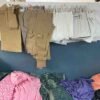Leading by Example – What Echo Earth Can Learn from GECA-Certified Textile Pioneers
In our last post, we explored the strict criteria and lifecycle approach of GECA’s textile standard. Now let’s get inspired by the brands that are already walking the talk—leveraging GECA certification not just as a stamp of approval, but as a business and design philosophy. Let’s spotlight two game-changing Australian brands: Sustainable Living Fabrics and RIM Fabrics—both GECA-certified and globally respected for their commitment to truly responsible production. Sustainable Living Fabrics: 400 Shades of Responsible Luxury This brand manufactures over 400 commercial upholstery fabrics in Australia, serving architectural, interior, and corporate clients. Every fabric in their Green Living Collection carries GECA certification. What sets them apart: 100% Australian-made with full traceability Zero use of harmful chemical finishes Compliant with both social and environmental criteria Durable, high-performing fabrics made for public spaces Their journey shows that sustainability doesn’t mean compromising on quality, style, or performance. At Echo Earth, we’re developing a similar model: our hemp and bamboo blends are being used in stylish western wear, home furnishings, and even undergarments—proof that eco can also be chic. RIM Fabrics: Weaving Ethics into Every Thread RIM Fabrics is another leader in the space, offering premium interior textiles with strong design sensibility and ethical manufacturing credentials. Their focus on minimal environmental impact, durability, and recyclability reflects the core of GECA’s standard. Why it matters to Echo Earth: RIM’s success proves that certified sustainable textiles are commercially viable in global design markets. Designers trust these certifications when specifying materials for large-scale projects—retail, hospitality, architecture. Echo Earth’s wide catalogue—from minimal-MOQ fabrics to customized dyeing—has the potential to serve the same audience if aligned with transparent certification systems. What brands like RIM and SLF have nailed is this: certification is just the beginning. The real magic happens when they tell the story—through branding, packaging, digital content, and customer education. At Echo Earth, we are now focusing on telling our story better. We’re not just exporters. We’re storytellers of fabric that regenerates, empowers rural artisans, and gives designers globally a better option to fast fashion. What Should Indian Exporters Take from This? Global buyers want proof, not promises. Third-party ecolabels like GECA, GOTS, or OEKO-TEX are essential tools. Design still rules. Sustainable fabrics must also feel good, drape well, and excite the designer. B2B trust is built through transparency. Share your production practices, your worker rights framework, your sourcing model. Echo Earth is not far behind. In fact, with India’s traditional textile skills, plant-based innovation (like hemp), and cost competitiveness, we could lead the next global wave—provided we align with globally accepted standards like GECA. Final Thoughts: Walking the Talk GECA’s standard is more than a technical document—it’s a roadmap for the future of ethical, traceable, and truly sustainable textiles. As we look ahead, Echo Earth aims to strengthen partnerships with certification bodies and offer verifiable sustainability across every metre of fabric we export. Stay tuned as we bring you more certified options, more impactful designs, and more stories from the green textile revolution we’re proud to be part of.





